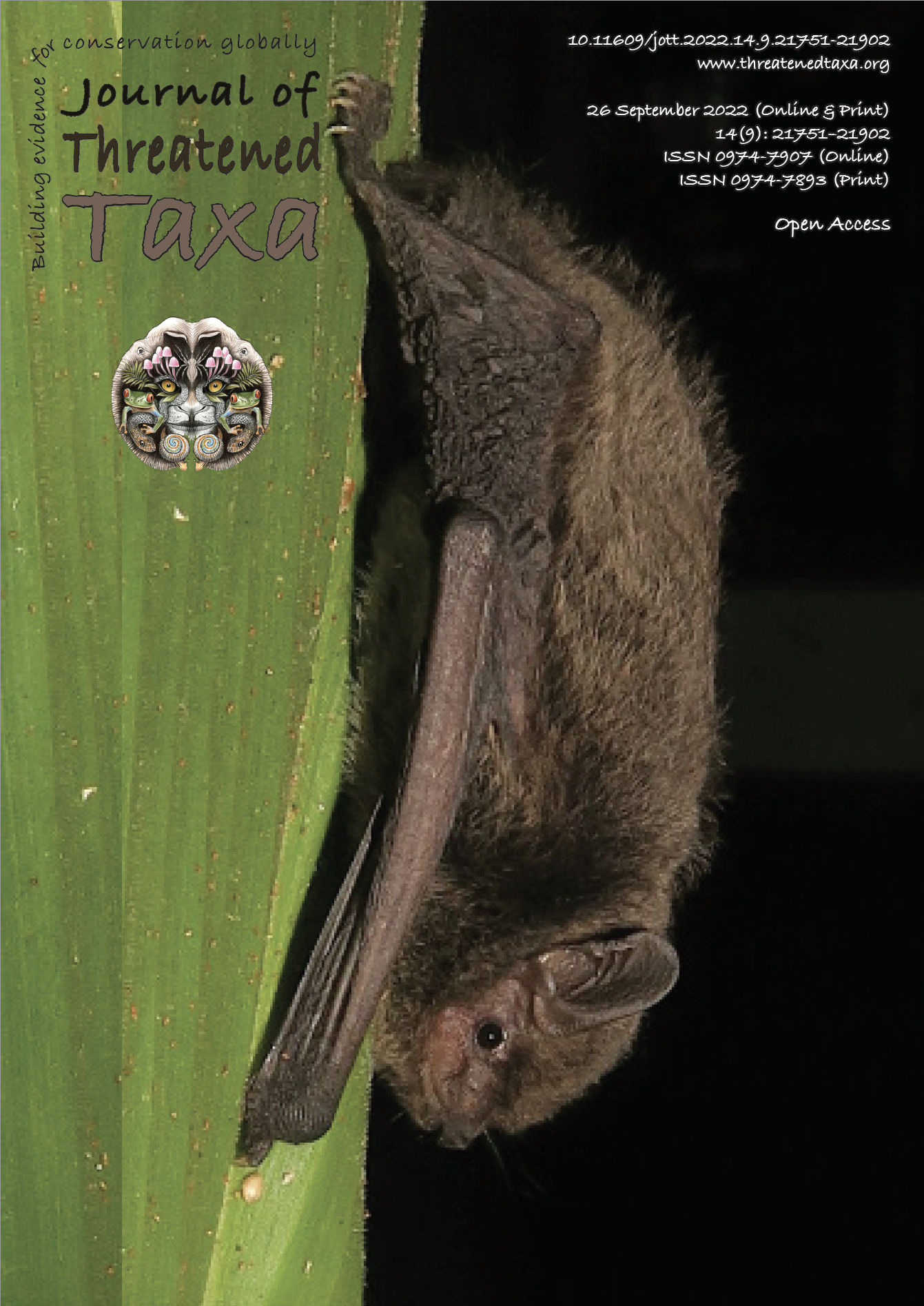Population density and nesting behaviour of Indian Giant Squirrel Ratufa indica (Erxlebeln, 1777) in Bhimashankar Wildlife Sanctuary, Western Ghats of Maharashtra, India
Main Article Content
Abstract
The Indian Giant Squirrel Ratufa indica (Erxlebeln, 1777) has been officially designated as Maharashtra’s state animal. It is restricted to the eco-sensitive Western Ghats region and is currently classified as Least Concern species on the IUCN Red List. However, the species is dependent on intact habitat and is negatively impacted by habitat fragmentation. Population density and nesting behavior were studied in a major habitat in the tropical semi-evergreen and evergreen forest of India’s Bhimashankar Wildlife Sanctuary. Two-hundred-and-twenty-three direct sighting along 60 km line transects were used to estimate squirrel density. It averaged 13.9±0.18 squirrels/km2. Nesting characteristics were evaluated using 4,224 nests. The squirrel uses 52 different tree species for nesting, with Mangifera indica (15.57%), Olea dioica (14.65%), and Mallotus phillippensis (9.78%) being the most popular. The drays were found on trees that are taller than average, have a massive girth at the breast height, and have continuous closed canopies. To avoid predators, Indian Giant Squirrels usually flee to the nearest adjacent tree.
Article Details

This work is licensed under a Creative Commons Attribution 4.0 International License.
Authors own the copyright to the articles published in JoTT. This is indicated explicitly in each publication. The authors grant permission to the publisher Wildlife Information Liaison Development (WILD) Society to publish the article in the Journal of Threatened Taxa. The authors recognize WILD as the original publisher, and to sell hard copies of the Journal and article to any buyer. JoTT is registered under the Creative Commons Attribution 4.0 International License (CC BY), which allows authors to retain copyright ownership. Under this license the authors allow anyone to download, cite, use the data, modify, reprint, copy and distribute provided the authors and source of publication are credited through appropriate citations (e.g., Son et al. (2016). Bats (Mammalia: Chiroptera) of the southeastern Truong Son Mountains, Quang Ngai Province, Vietnam. Journal of Threatened Taxa 8(7): 8953–8969. https://doi.org/10.11609/jott.2785.8.7.8953-8969). Users of the data do not require specific permission from the authors or the publisher.
References
Baskaran, N., S.Venkatesan, J. Mani, S.K. Srivastava & A.A. Desai (2011). Some aspects of the ecology of the Indian Giant Squirrel Ratufa indica (Erxleben, 1777) in the tropical forests of Mudumalai Wildlife Sanctuary, southern India, and their conservation implications. Journal of Threatened Taxa 3(7): 1899–1908. https://doi.org/10.11609/JoTT.o2593.1899-908
Borges, R.M. (1992). A nutritional analysis of foraging in the Malabar giant squirrel (Ratufa indica). Biological Journal of the Linnean Society 47(1): 1–21.
Borges, R.M. (1993). Figs, Malabar giant squirrels, and fruit shortages within two tropical Indian forests. Biotropica 25(2): 183–190.
Datta, A. (1998). The anti-predatory response of the Indian giant squirrel Ratufa indica to predation attempts by the Crested Hawk Eagle Spizaetus cirrhatus limnaetus. Journal of The Bombay Natural History Society 95: 332–335.
Datta, A. & S.P. Goyal (1996). Comparison of forest structure and use by the Indian giant squirrel (Ratufa indica) in two riverine forests of Central India. Biotropica 28(3): 394–399.
Jathanna, D., N.S. Kumar & K.U. Karanth (2008). Measuring Indian giant squirrel (Ratufa indica) abundance in southern India using distance sampling. Current Science 95(07): 885–888.
Livezey, K.B., E. Fernández-Juricic & D.T. Blumstein (2016). Database of bird flight initiation distances to assist in estimating effects from human disturbance and delineating buffer areas. Journal of Fish and Wildlife Management 7(1): 181–191.
Mehta, P. & J. Kulkarni (2011). Status and Distribution of Malabar Giant Squirrel Ratufa indica in Western Ghats of Maharashtra, India. Wildlife Research and Conservation Society, Pune. Final Technical Report submitted to WWF New Delhi and Rufford’s Small Grants Program, United Kingdom, 74 pp.
Rajamani, L. & H. Marsh (2010). Using parallel regional-and local-scale initiatives to inform conservation management of rare wildlife: A case study of the dugong Dugong dugon in Sabah, Malaysia. Endangered Species Research 13(1): 17–23.
Shrotriya, A., K.S.D. Rout & P.K. Dash (2017). Nesting and feeding habitats of Indian giant squirrel (Ratufa indica) in Karlapat wildlife sanctuary, India. Animal Biodiversity and Conservation 40(1): 63–69. https://doi.org/10.32800/abc.2017.40.0063
Somanathan, H., S. Mali & R.M. Borges (2007). Arboreal larder-hoarding in the tropical Indian giant squirrel Ratufa indica. Ecoscience 14(2): 165–169.
Thomas, L., S.T. Buckland, E.A. Rexstad, J.L. Laake, S. Strindberg, S.L. Hedley, J.R. Bishop, T.A. Marques & K.P. Burnham (2010). Distance software: Design and analysis of distance sampling surveys for estimating population size. Journal of Applied Ecology 47(1): 5–14. https://doi.org/10.1111/j.1365-2664.2009.01737

